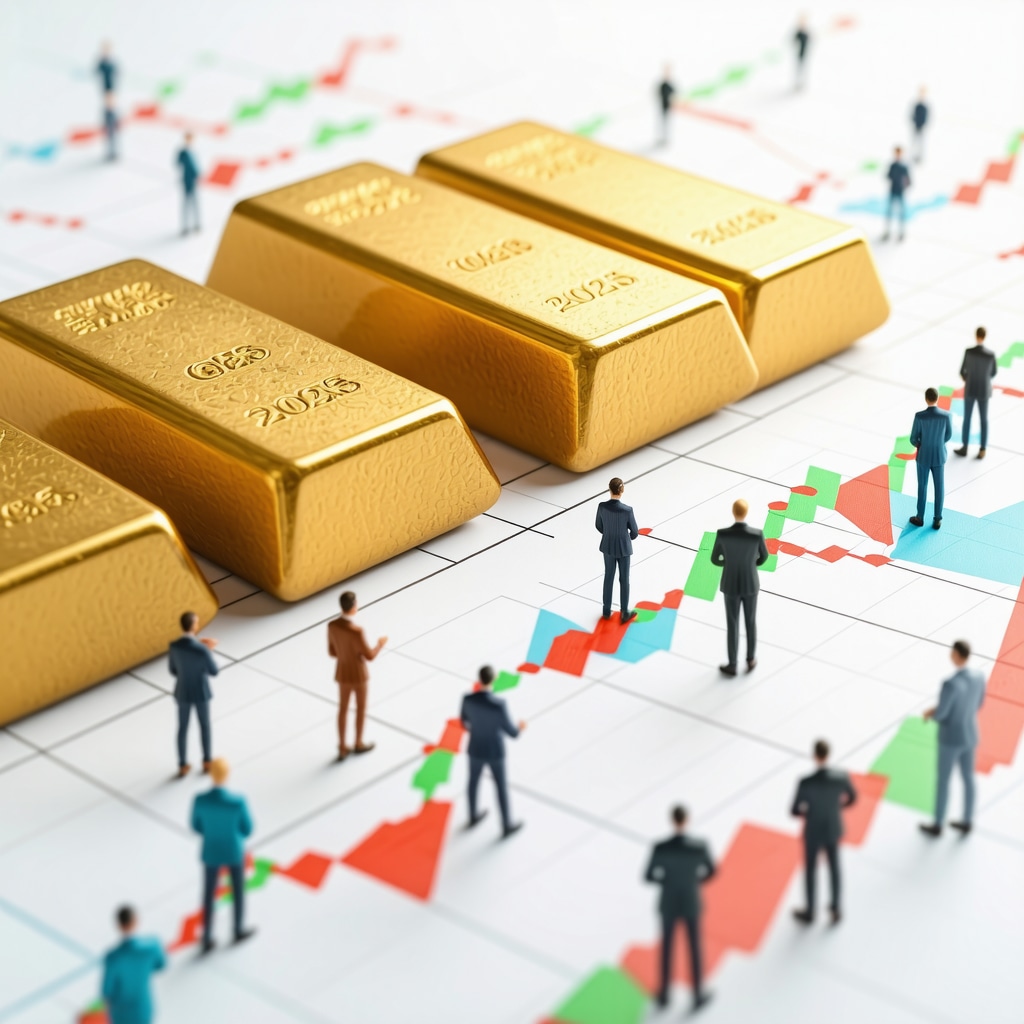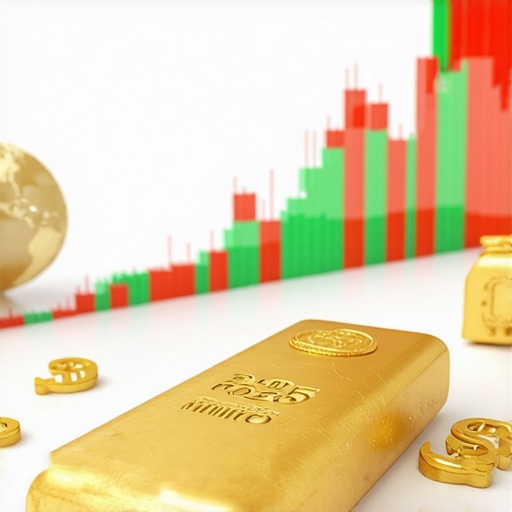Understanding the Intricacies of Gold Supply & Demand for Strategic Investment in 2025
As global markets evolve amidst geopolitical tensions, inflationary pressures, and technological innovations, the fundamental forces shaping gold supply and demand are becoming increasingly complex. Recognizing these dynamics is paramount for investors aiming to optimize wealth preservation and growth in 2025. This analysis synthesizes expert insights, market trends, and macroeconomic factors to equip discerning investors with a nuanced perspective on gold’s future trajectory.
Unraveling the Supply Chain: Key Factors Influencing Gold Availability
How Do Central Bank Policies and Mine Production Impact Gold Supply?
The dual influence of central bank gold purchases and mine output significantly modulates global gold availability. Central banks, particularly in emerging markets, have resumed accumulation strategies, signaling a reinforcement of gold’s role as a reserve asset. Concurrently, geopolitical disruptions and environmental regulations are affecting mine productivity, sometimes constraining supply. For instance, the World Gold Council reports that central banks added over 400 tonnes of gold in 2024, underscoring institutional demand’s growing footprint (source).
Demand Side: Evolving Drivers and Sectoral Trends
What Are the Emerging Demand Drivers in Jewelry, Technology, and Investment?
In 2025, demand across sectors is influenced by shifting consumer preferences, technological integration, and macroeconomic uncertainties. Jewelry remains a primary driver, especially in Asia, where rising middle-class affluence fuels demand. Simultaneously, technological sectors are consuming more gold for electronics, with innovations in 5G and electric vehicles expanding usage. Investment demand, driven by inflation hedging and portfolio diversification, continues to surge, driven by institutional investors and ETF assets. According to a report by the International Monetary Fund, these demand segments are expected to grow at an annual rate of 3-5% in the coming year.
Can Market Sentiment and Policy Uncertainty Disrupt Gold Price Trends?
Market sentiment, often shaped by geopolitical events and fiscal policy shifts, can induce significant price volatility. For example, escalating tensions in Eastern Europe or trade disputes can trigger safe-haven flows into gold, temporarily inflating prices. Conversely, a stabilization of geopolitical risks may lead to profit-taking and price corrections. Investors must remain vigilant, leveraging technical analysis and macroeconomic forecasts to navigate these fluctuations effectively. The complex interplay of these factors underscores the importance of comprehensive market analysis.
What Strategies Can Sophisticated Investors Use to Capitalize on Supply-Demand Trends?
Advanced investors often employ a combination of physical gold acquisitions, futures contracts, and diversified ETF portfolios to hedge against volatility and inflation. Tactical approaches include monitoring central bank reports, geopolitical developments, and technological innovations. Engaging in gold trading strategies that incorporate technical indicators and macroeconomic data can enhance returns. Furthermore, aligning investments with supply-demand forecasts derived from comprehensive analysis yields a strategic advantage in navigating 2025’s market landscape.
For ongoing insights, explore gold investment strategies designed for high-net-worth individuals and institutional portfolios. And consider contributing your expert insights to this evolving field, fostering a richer understanding of gold’s role in global finance.
Deciphering the Impact of Global Economic Shifts on Gold Demand in 2025
As the global economy continues to evolve, understanding how macroeconomic factors influence gold demand is vital for strategic investors. Factors such as inflation rates, currency fluctuations, and geopolitical stability play significant roles in shaping investor behavior and industry consumption. For instance, rising inflation often prompts increased interest in gold as a safe-haven asset, while currency depreciation can make gold more attractive for international buyers. According to a comprehensive market analysis, these economic drivers are expected to accelerate in 2025, further impacting gold prices.
How Will Technological Innovations and Emerging Markets Drive Future Gold Demand?
Technological advancements, especially in electronics, renewable energy, and electric vehicles, are expected to boost gold’s role in high-tech manufacturing. As industries adopt more sophisticated technologies, the demand for gold in components like connectors, microchips, and sensors will likely increase. Simultaneously, emerging markets such as Africa and Southeast Asia are experiencing rapid middle-class growth, fueling local jewelry demand and investment interest. These trends underscore the importance of tracking industry-specific demand to forecast price trajectories accurately.
What Can Investors Do to Leverage These Demand Dynamics for Wealth Preservation?
To capitalize on these emerging trends, savvy investors should diversify their holdings across physical gold, ETFs, and mining stocks. Engaging in active portfolio management with a focus on gold trading strategies can help mitigate volatility and optimize returns. Moreover, staying informed about central bank policies and international trade developments—key price drivers—is essential for timing entry and exit points effectively. Expert analysis suggests that integrating technical and fundamental insights creates a robust framework for navigating 2025’s complex market environment.
How Can Investors Use Advanced Tools to Predict Gold Price Movements in 2025?
Utilizing sophisticated analytical tools, such as macroeconomic modeling, sentiment analysis, and machine learning algorithms, can provide a competitive edge. These technologies process vast datasets—covering supply-demand dynamics, geopolitical risks, and economic indicators—to generate accurate forecasts. For example, predictive analytics can signal potential price surges following central bank gold purchase reports or geopolitical crises. To deepen your understanding, explore resources on market analysis techniques that combine expert insights with data-driven approaches.
Feel free to share your thoughts or experiences with gold investment strategies in the comments below, and don’t forget to check out our detailed guides on gold IRA investments and inflation hedging with gold for more actionable tips to secure your wealth in 2025.
Deciphering the Role of Geopolitical Shifts and Economic Policies on Gold Prices in 2025
As geopolitical tensions and macroeconomic policies become more intricate, their ripple effects on gold prices demand a sophisticated understanding. Fluctuations in diplomatic relations, trade agreements, and sanctions can swiftly alter investor sentiment, often triggering flight-to-safety movements. For instance, escalating conflicts or trade disputes can lead to increased central bank gold acquisitions, as nations seek to diversify reserves away from volatile currencies. According to the World Gold Council, these geopolitical catalysts can induce short-term spikes, but their long-term influence depends on the stability of global governance structures (source). Investors should leverage geopolitical risk indices, combined with macroeconomic data, to anticipate price trajectories more accurately.
How Do Macroeconomic Policy Changes Affect Gold Investment in 2025?
Fiscal stimulus measures, interest rate adjustments, and monetary policy shifts profoundly impact gold’s attractiveness as an inflation hedge. An expansionary fiscal policy may boost inflation expectations, prompting increased demand for physical gold and ETFs. Conversely, tightening monetary policies could strengthen the dollar, potentially dampening gold prices unless driven by inflation fears. The International Monetary Fund highlights that synchronized policy actions among major economies can lead to unpredictable market reactions, necessitating a nuanced analysis of policy coherence and timing (source). Advanced investors utilize economic models that integrate policy forecasts with supply-demand fundamentals, creating a predictive framework for navigating 2025’s uncertain landscape.
The Impact of Innovation and Digital Transformation on Gold’s Future Demand
Emerging technological advancements are reshaping gold’s role in high-tech sectors, from quantum computing to renewable energy systems. The integration of blockchain technology and digital assets further complicates traditional investment paradigms, introducing new channels for gold-backed cryptocurrencies and tokenized assets. The Bank for International Settlements emphasizes that technological innovation not only increases industrial demand but also enhances liquidity and accessibility for investors worldwide (source). As these trends accelerate, the ability to accurately gauge their influence on gold prices hinges on understanding technological adoption rates and regulatory developments across jurisdictions.
What Advanced Analytical Tools Are Essential for Forecasting 2025 Gold Market Movements?
To stay ahead of the curve, investors should employ a suite of sophisticated analytical tools, including macroeconomic simulation models, sentiment analysis algorithms, and machine learning-driven predictive analytics. These technologies synthesize vast datasets—covering geopolitical risks, economic indicators, and market sentiment—into actionable insights. For example, sentiment analysis of news flows and social media can reveal early signs of investor shifts, while machine learning models can identify subtle patterns preceding price movements. The Gold Institute recommends integrating these tools into a comprehensive decision-making process to optimize timing and asset allocation (source). Mastering these advanced techniques grants investors a strategic advantage in the volatile landscape of 2025 gold markets.
Engaged investors are encouraged to continuously refine their analytical toolkit and stay informed through expert reports and real-time data feeds. Share your insights or experiences with these advanced strategies below, and explore our detailed guides on integrating gold into diversified portfolios for sustained wealth preservation in 2025 and beyond.
Decoding the Interplay Between Mining Innovations and Regulatory Frameworks in Gold Supply
As technological advancements revolutionize mineral extraction and processing, understanding their implications on gold availability becomes crucial for investors. Innovations such as autonomous mining equipment, AI-driven exploration, and environmentally sustainable extraction techniques are potentially increasing mine efficiencies and lowering costs. Simultaneously, evolving regulatory environments—ranging from stricter environmental standards to geopolitical trade restrictions—may either facilitate or hinder supply expansion. According to the US Geological Survey, these technological and regulatory shifts are expected to significantly influence global gold mine output and availability in 2025, requiring investors to stay informed about emerging trends and policy changes.
How Do Shifts in Consumer Behavior and Emerging Markets Shape Gold Demand?
Changing consumer preferences, especially in burgeoning economies, are reshaping gold’s demand landscape. The rise of middle-class affluence in regions such as Southeast Asia and Africa fosters increased jewelry consumption and investment interest. Additionally, cultural factors—such as the continued importance of gold in wedding traditions and savings—amplify demand. The influence of digital platforms, peer-to-peer trading, and online jewelry markets further accelerates access to gold products. The World Bank highlights that these demographic and behavioral shifts will sustain demand growth, compelling investors to consider regional demand trends alongside macroeconomic indicators.
What Are the Cutting-Edge Methods for Analyzing Gold Market Sentiment and Price Movements?
In an environment characterized by rapid information flow and complex geopolitical signals, sophisticated analytical tools are indispensable. Machine learning algorithms, natural language processing of news and social media, and real-time sentiment indices enable traders to detect early market signals. These technologies analyze vast data streams, identifying subtle shifts in investor confidence and risk appetite. The World Gold Council emphasizes that integrating these tools into investment strategies enhances predictive accuracy, especially during volatile periods. For example, sentiment analysis can forecast short-term price surges following geopolitical crises, providing a strategic edge.
How Can Investors Leverage Future-Oriented Strategies to Optimize Gold Portfolio Performance?
Harnessing forward-looking quantitative models, including scenario analysis and stress testing, allows investors to prepare for multiple market contingencies. Diversification across physical assets, futures, options, and gold-backed cryptocurrencies mitigates risks associated with supply shocks and demand fluctuations. Additionally, active asset allocation—guided by real-time data and expert macroeconomic forecasts—enables dynamic responses to evolving conditions. The Financial Analyst Institute advocates for integrating these advanced techniques to enhance portfolio resilience and capitalize on emerging opportunities in the gold market.
What Role Do Geopolitical and Economic Policy Uncertainties Play in Shaping 2025 Gold Prices?
Geopolitical tensions, sanctions, and fiscal policies are inextricably linked to gold’s safe-haven status. For instance, escalating conflicts or trade disruptions often prompt central banks and institutional investors to bolster holdings, driving up prices. Conversely, resolution of tensions and stabilization of policies might lead to profit-taking and price corrections. According to the World Bank, the synchronization of global economic policies and geopolitical stability will be vital in determining gold’s price trajectory. Investors should monitor geopolitical risk indices and policy developments to anticipate market shifts more accurately.
Engage with these insights to deepen your understanding of the complex forces shaping gold markets in 2025. Implementing sophisticated analytical tools and staying attuned to global developments will position you advantageously in this dynamic landscape.
Expert Insights & Advanced Considerations
1. Strategic Diversification Is Key
In 2025, savvy investors recognize that diversifying across physical gold, ETFs, and mining stocks mitigates risks associated with supply disruptions and demand fluctuations, ensuring portfolio resilience amid market volatility.
2. Monitoring Policy and Geopolitical Risks Enhances Predictive Accuracy
Keeping a close eye on central bank policies, international trade relations, and geopolitical tensions provides critical signals for anticipating short-term price movements and long-term trends in gold markets.
3. Leveraging Technological Advancements Offers Competitive Edge
Utilizing advanced analytical tools such as machine learning, sentiment analysis, and macroeconomic modeling allows investors to forecast gold price trajectories more precisely, capitalizing on emerging opportunities.
4. Understanding Supply Chain Innovations Is Fundamental
Investors should stay informed about technological innovations in mining and processing, as autonomous equipment and sustainable practices could significantly influence gold availability and costs.
5. Recognizing Emerging Market Demand Dynamics
Growing middle classes and cultural factors in regions like Southeast Asia and Africa are expected to sustain demand, making regional trends vital for strategic positioning in 2025.
Curated Expert Resources
- World Gold Council: The authoritative source for market analysis, supply-demand statistics, and industry reports essential for deep expertise in gold markets.
- International Monetary Fund (IMF): Offers macroeconomic data and forecasts that inform investment decisions related to inflation, currency, and economic policy impacts on gold.
- Bank for International Settlements (BIS): Provides insights into technological innovations and regulatory developments shaping gold industry practices and demand.
- US Geological Survey: Critical for understanding mining innovations, resource estimates, and supply chain advancements.
- Financial Analysts & Market Data Platforms: Utilize tools like Bloomberg or Reuters for real-time analytics, sentiment analysis, and predictive modeling to stay ahead of market shifts.
Final Expert Perspective
In navigating the complex landscape of gold supply and demand for 2025, integrating expert insights with advanced analytical tools is essential for strategic advantage. Recognizing the interplay of technological innovation, geopolitical risks, and emerging market demand will empower investors to make informed decisions and optimize wealth preservation. Embrace continuous learning and utilize authoritative resources to stay at the forefront of market developments. Your engagement—whether through sharing insights or exploring comprehensive guides—can contribute to a more nuanced understanding of gold’s evolving role in global finance. Stay vigilant, stay informed, and position yourself confidently for the opportunities ahead.










